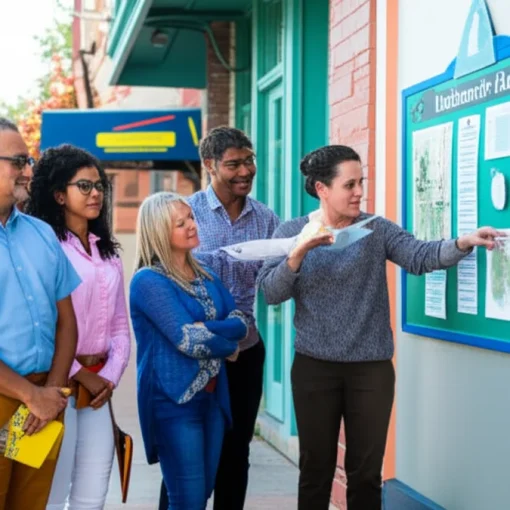Alright, let’s talk honestly for a minute. If you’re trying to get a business off the ground or grow one out here in rural Wisconsin, one of the first questions that probably keeps you up at night is, Okay, where’s the money coming from? It’s a classic challenge, right? Accessing capital and knowing where to find the right resources can feel a lot tougher when you’re not right in the middle of a bustling city center with banks and venture capital firms seemingly around every corner. But here’s the thing, and it’s something I’ve seen play out time and again: there are programs out there, specifically designed to help entrepreneurs just like you in rural areas, at both the state and federal levels. You just need to know where to look and, maybe more importantly, how to approach them. This isn’t about finding a magic money tree, but it is about navigating a system that wants to support rural growth, if you can figure out its language. Let’s dig into some of the key players and what they offer.
Why Funding Can Feel Different When You’re Rural
Before we jump into specific programs, let’s acknowledge the elephant in the room. Getting a loan or finding investment in a smaller community isn’t always as straightforward as it might be in a big metro area. Sometimes, local banks might have smaller lending capacities, or investors might be focused elsewhere. Plus, the unique dynamics of a rural market – think seasonality, specific industry focuses like agriculture or tourism, maybe a smaller local customer base – can present challenges that traditional funding models don’t always seem to fit.
This is precisely where state and federal programs often come in. They’re designed to bridge those gaps, reduce risk for lenders, and provide direct assistance where the private market might fall short. They recognize that rural businesses are vital to the economy and need tailored support.
Navigating Federal Funding Opportunities
When we talk about federal money for rural businesses, one agency immediately comes to mind: the U.S. Department of Agriculture (USDA). Now, don’t let the name fool you; they fund way more than just farms. Their Rural Development arm is a powerhouse for non-agricultural rural businesses.
USDA Rural Development: A Key Player
I’ve helped several clients tap into USDA Rural Development programs, and while the paperwork can feel daunting – let’s be honest, it’s government paperwork! – the potential impact is huge. They have several programs worth looking into:
- Business & Industry (B&I) Loan Guarantee Program: This is probably one of the biggest. It doesn’t give you the money directly, but it guarantees a significant portion of a loan you get from a conventional lender (like a bank). Why does this matter? It makes the bank way more likely to lend you money, especially for larger projects like real estate, construction, equipment, or even working capital. The guarantee reduces the bank’s risk. My advice here? Find a lender who has experience with USDA B&I guarantees. Not all banks do, and working with one who knows the ropes can make a world of difference in navigating the application process.
- Rural firm Development Grants (RBDG): This is a bit different. These are grants (which means you don’t pay them back, generally) given to public entities like towns, communities, state agencies, authorities, or non-profits. But guess who benefits? Small rural businesses! The grant money is used for things like technical assistance, training, establishing business incubators, or even acquiring land or constructing buildings for small businesses. So, while you might not apply directly, your local economic development group or town might, and the benefits flow down to you. It’s worth asking your local community leaders if they’ve ever applied for or considered an RBDG.
- Rural Microentrepreneur Assistance Program (RMAP): This program provides loans and grants to non-profit organizations that, in turn, provide microloans (up to $50,000) and technical assistance to rural microentrepreneurs (businesses with 10 or fewer employees). If you’re a particularly small business looking for a relatively small amount of capital and some guidance, finding one of these intermediary organizations could be your ticket.
Working with USDA can feel like navigating a maze, no doubt about it. But the funding can be substantial and targeted specifically at rural needs. Perseverance and good preparation (read: a solid business plan and financials) are your best friends here.
The Small firm Administration (SBA) in Rural Contexts
While the SBA serves businesses everywhere, their programs are absolutely available to rural entrepreneurs in Wisconsin. Their most common offering is the 7(a) Loan Program, which, like the USDA B&I program, involves loan guarantees to lenders.
The SBA also has programs like the 504 Loan Program, which is great for funding fixed assets (real estate, machinery) through a partnership with a Certified Development Company (CDC). There are CDCs in Wisconsin that work with businesses statewide, including rural areas.
What’s key with the SBA, whether rural or not, is finding a good bank that’s an SBA Preferred Lender. They’ve got streamlined processes and understand the programs deeply. Don’t just walk into any bank; ask if they have an SBA lending specialist. It will save you so much time and frustration.
Wisconsin State Programs: Homegrown Support
Okay, let’s bring it closer to home. Wisconsin has its own set of resources and programs designed to foster economic growth, and many are particularly beneficial, or even specifically aimed at, rural areas. The main hub for this is the Wisconsin Economic Development Corporation (WEDC).
WEDC: Wisconsin’s Economic Engine
WEDC has a range of tools in its toolbox. They work through various programs, often in partnership with regional economic development organizations and local communities.
- Community Development Investment (CDI) Program: This program provides grants to communities for projects that stimulate company development and job creation. Again, like the USDA RBDG, you might not apply directly, but your town or county could use these funds for infrastructure or facilities that support local businesses.
- Developer Ready Sites Program: While maybe not direct funding for your business, this helps communities prepare shovel-ready sites, making it easier and potentially cheaper for businesses to expand or locate in rural areas. It addresses a fundamental need for physical space.
- Specific Tax Credits and Programs: WEDC oversees various tax credit programs that can incentivize job creation, investment, and specific types of business activity. You’ll need to check their current offerings, as these can change, but things like job creation tax credits or credits for investing in underserved areas could apply to your rural company.
- Matching Grants and Seed Accelerators: Keep an eye on WEDC initiatives that partner with accelerators or offer matching grants for specific types of innovation or enterprise growth. These are often competitive but can give crucial early-stage funding or help you access private investment.
My take on WEDC programs? They often require working through a local partner or community entity. Building relationships with your local and regional economic development professionals is absolutely essential. They are your guides to the state-level programs and can help you figure out what might fit. Don’t try to figure it all out alone!
Regional and Local Initiatives
Beyond the state level, don’t forget about regional planning commissions, county economic development offices, and local foundations. These entities often have smaller grant programs, revolving loan funds, or access to resources specifically for businesses within their geographic area. Sometimes the most accessible funds are right in your backyard. A quick search or a call to your county clerk’s office can point you in the right direction.
Beyond the Money: Resources and Support Are Just As Vital
Look, getting funding is huge, but it’s not the only challenge – or the only help available. Sometimes, the right advice or connection is worth more than a small grant. State and federal programs understand this too.
Technical Assistance and Mentoring
This is where I’ve seen countless entrepreneurs turn an idea into a thriving business. The SBA supports Small Business Development Centers (SBDCs) across Wisconsin. These centers offer free or low-cost counseling, training, and resources. They can help you refine your business plan, understand your financials, figure out marketing, and yes, navigate those funding applications we just talked about. They have locations around the state, including those serving rural areas. Find your nearest one – it’s a non-negotiable step in my book.
SCORE, another SBA-backed program, connects you with retired executives and business owners who volunteer their time to mentor entrepreneurs. The wisdom and experience they share can be invaluable.
Also, check with UW-Extension offices and technical colleges. They often have business development programs, workshops, and faculty expertise that can be incredibly helpful, and they are spread throughout the state, making them accessible to rural communities.
Building Your Network
Don’t underestimate the power of connecting with other entrepreneurs and business leaders in your area. Local chambers of commerce, industry associations, and regional economic development groups host events and provide networking opportunities. These connections can lead to customer referrals, supplier relationships, and shared learning experiences. Sometimes, just hearing how someone else tackled a similar problem is the resource you needed most.
Putting It All Together: Your Action Plan
Navigating this landscape takes time and effort. It’s not a passive process. You can’t just wish the money into existence or expect programs to land in your lap.
- Get Business Plan Ready: No matter the funding source, you need a solid – well-thought-out business plan and clear financial projections. This is your roadmap and your primary tool for convincing anyone – a lender, a grant committee, a mentor – that you’re serious and your idea is viable. If this isn’t sharp, nothing else matters.
- Connect Locally: Reach out to your regional SBDC, your county economic development office, and your local bank (especially if they have SBA experience). They are your first line of defense and can often point you to the most relevant state and federal programs.
- Do Your Homework: Look at the websites for USDA Rural Development and WEDC. Don’t get overwhelmed by the sheer volume of programs, but try to identify the ones that seem like they might fit your company stage and needs (startup? expansion? specific industry?).
- Be Patient and Persistent: Applying for government-backed funding or grants takes time. There’s bureaucracy, there are cycles, and there’s competition. Don’t get discouraged by the first no, or the complexity of the application. Ask for feedback if you’re denied.
- Leverage Resources Beyond Money: Actively seek out the technical assistance, mentoring, and training opportunities available. They can improve your venture operations and make you a stronger candidate for funding down the line.
Look, building a business anywhere is tough, and doing it in a rural setting has its own unique flavor of challenges. But the potential rewards – revitalizing a Main Street, creating local jobs, serving a community you care about – are immense. The state and federal programs we’ve talked about are tools to help you achieve that. They aren’t perfect, and they necessitate effort, but they are absolutely there, waiting for dedicated Wisconsin entrepreneurs like you to put them to good use. Go make it happen.




